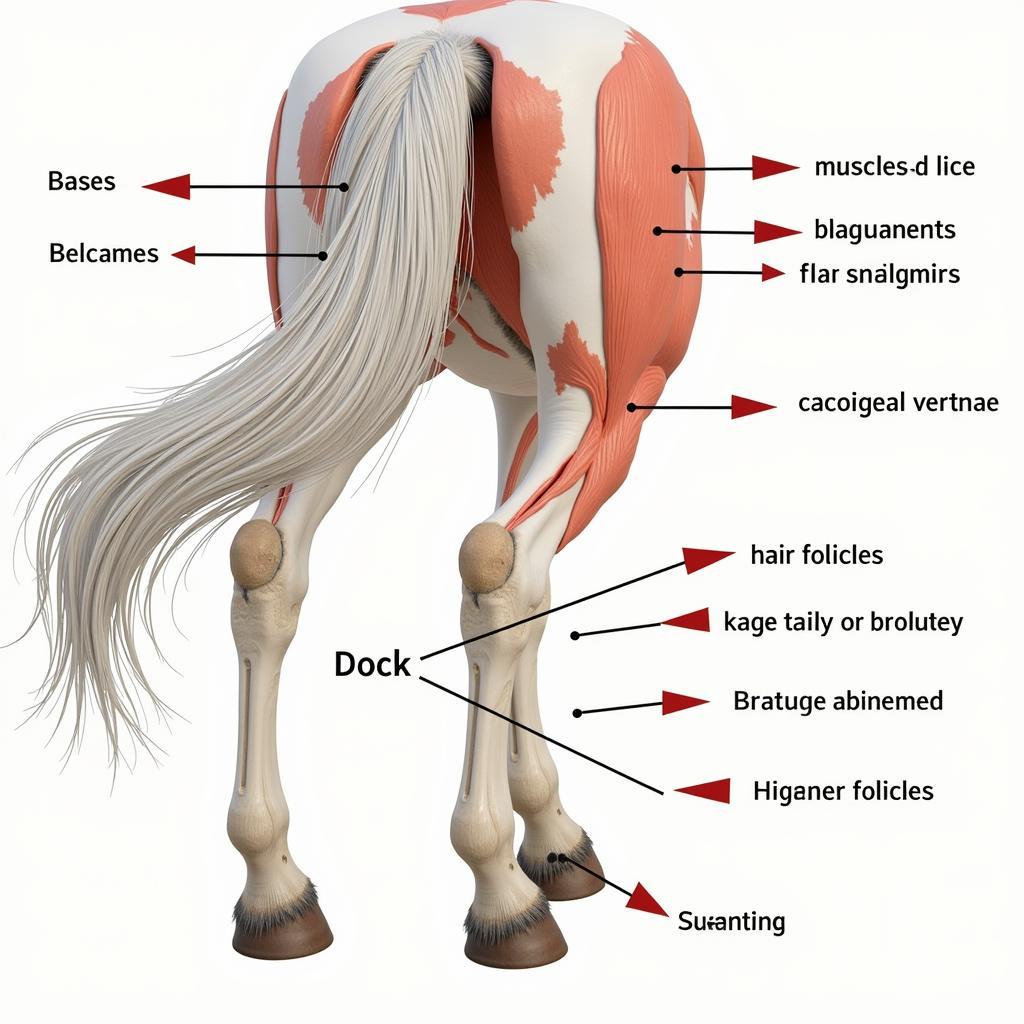A Horse Hair Tail, a magnificent cascade of flowing strands, is much more than just an aesthetic feature. It plays a crucial role in communication, fly control, and even balance. Understanding its structure, care, and common issues can help horse owners appreciate its importance and ensure its well-being. Let’s delve into the fascinating world of the horse hair tail.
The Anatomy and Function of a Horse’s Tail
The horse’s tail is an extension of the vertebral column, composed of vertebrae, muscles, ligaments, and tendons. The long, flowing hairs that we admire originate from the tail dock, the fleshy, muscular base. These hair horse tail hairs, also known as the “skirt,” serve several vital purposes. They act as a highly effective fly swatter, keeping pesky insects at bay. The tail also plays a significant role in equine communication, expressing emotions ranging from contentment to agitation. Subtle twitches and swishes can indicate irritation, while a clamped-down tail can signal fear or pain. Furthermore, the tail assists with balance, especially during quick turns and sudden stops.
 Horse Tail Anatomy and Function
Horse Tail Anatomy and Function
Caring for Your Horse’s Tail: Tips and Techniques
Maintaining a healthy and beautiful horse hair tail requires regular grooming and attention. Brushing should be gentle, using a wide-toothed comb or a dedicated tail brush. Avoid pulling or tugging, which can damage the hair and cause discomfort. Washing the tail is important but should not be overdone, as excessive washing can strip the natural oils and lead to dryness. Conditioning treatments can help keep the horse tail hair soft, shiny, and tangle-free. Proper nutrition also plays a vital role in tail health, as a balanced diet provides the necessary nutrients for healthy hair growth.
Common Horse Tail Problems and Solutions
Several issues can affect a horse’s tail, including breakage, tangles, and even hair loss. These problems can stem from various factors, such as poor nutrition, inadequate grooming, or underlying medical conditions. Identifying the root cause is essential for effective treatment. For instance, a dull, brittle tail could indicate a nutritional deficiency, while excessive rubbing could suggest an allergic reaction or skin irritation. Consulting a veterinarian is recommended for persistent or severe tail problems.
How Can I Prevent My Horse’s Tail From Rubbing?
One common concern among horse owners is tail rubbing, a behavior that can lead to hair loss and skin damage. Several factors can contribute to this issue, including parasites, allergies, and dry skin. Providing a clean and comfortable environment, regular grooming, and addressing any underlying medical conditions can help alleviate tail rubbing. You can also consider using tail bags or wraps to protect the tail.
“A healthy tail is often a reflection of a horse’s overall health,” says Dr. Emily Carter, Equine Veterinarian at the Lexington Equine Clinic. “Pay attention to any changes in the tail’s appearance or behavior, as these can be early indicators of underlying health issues.”
Understanding the Importance of Tail Care
The horse’s tail is more than just a decorative element; it’s a vital tool for communication, fly control, and balance. Proper care ensures its health and functionality, contributing to the horse’s overall well-being. Neglecting tail care can lead to various problems, affecting not only the horse’s appearance but also its comfort and ability to communicate effectively. By understanding the anatomy, function, and common issues associated with the horse hair tail, owners can provide the best possible care for their equine companions.
Conclusion: The Majestic Horse Hair Tail
The horse hair tail, a symbol of equine beauty and strength, deserves our utmost care and attention. From its role in communication to its function in fly control, the tail is an essential part of a horse’s anatomy. By implementing proper grooming techniques and addressing any potential issues, we can ensure that our horses’ tails remain healthy, vibrant, and functional for years to come. Remember, a healthy clippers for horses are important, too!
FAQ
- How often should I brush my horse’s tail?
- What are the best products to use for horse tail care?
- How can I prevent my horse’s tail from getting tangled?
- What should I do if my horse’s tail is rubbing excessively?
- Can I braid my horse’s tail?
- What are the signs of a healthy horse tail?
- How can nutrition affect my horse’s tail health?
Common Scenarios and Questions
- Scenario: My horse’s tail is constantly tangled. Question: What type of detangler is best for horse tails?
- Scenario: My horse’s tail is rubbing against the fence. Question: How can I protect my horse’s tail from rubbing?
- Scenario: My horse’s tail looks dull and brittle. Question: What nutritional supplements can improve tail health?
Further Reading and Resources
Explore more about horse care on our website: horse hair lining and head of the bay horse show.
Contact Us
Need help with your horse’s tail or other equine care questions? Contact us at Phone Number: 0772127271, Email: [email protected] or visit us at QGM2+WX2, Vị Trung, Vị Thuỷ, Hậu Giang, Việt Nam. We have a 24/7 customer service team.